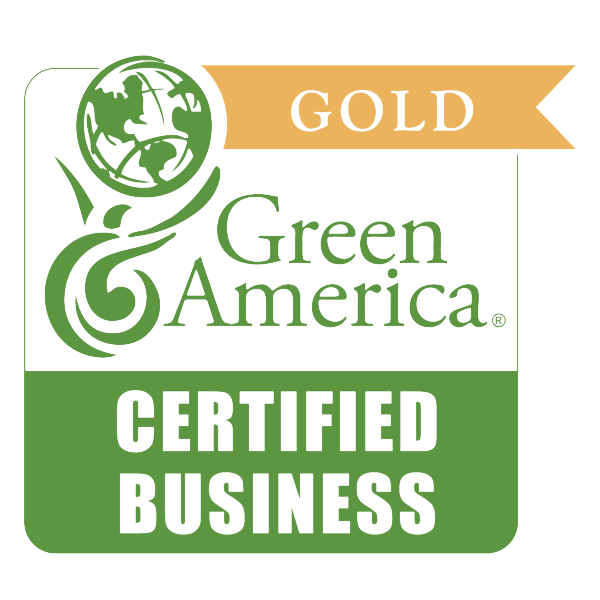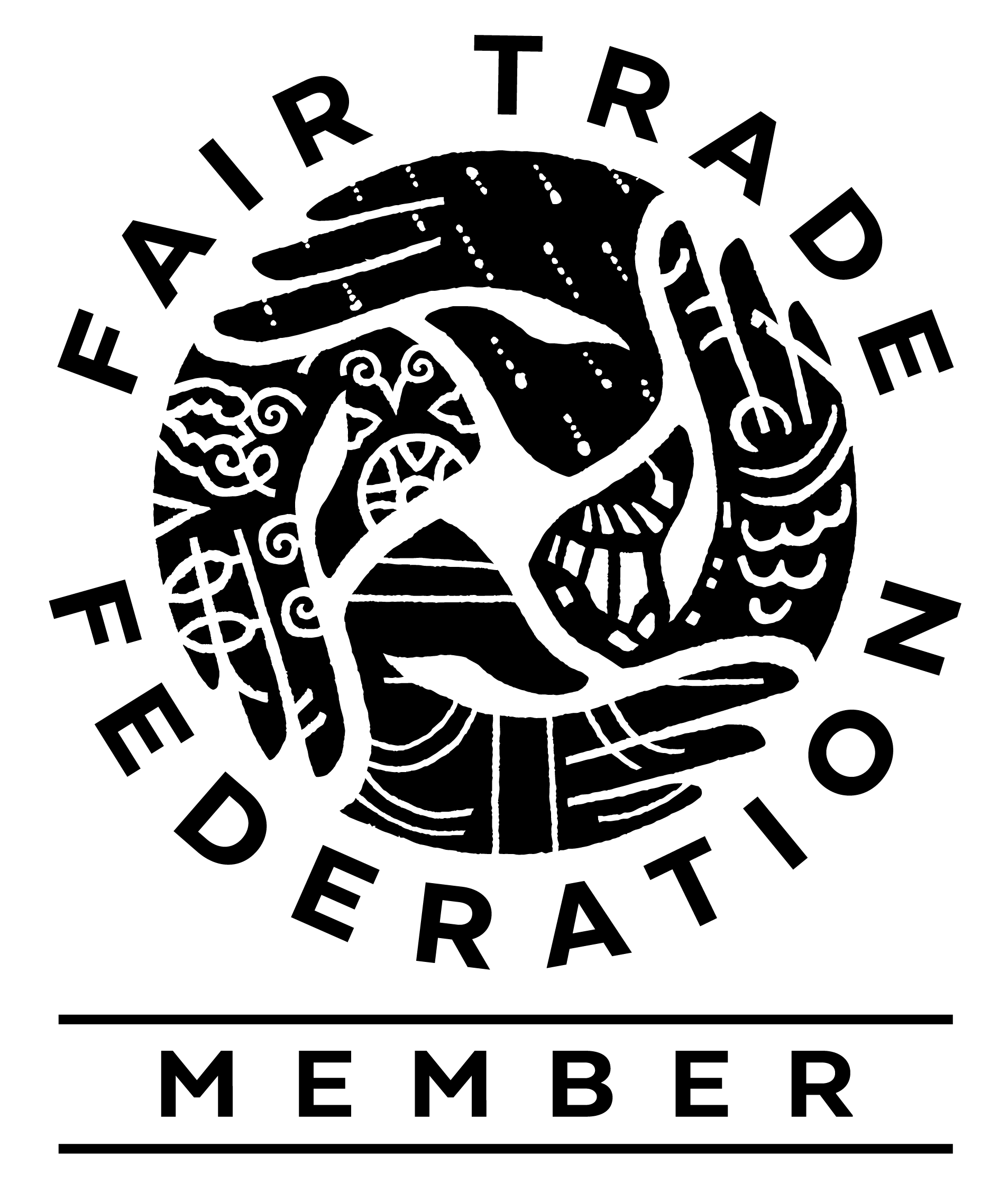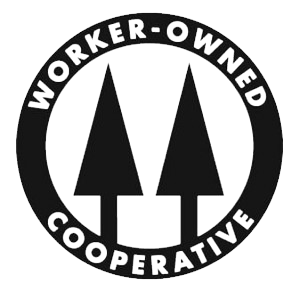Buyers, importers, roasters and consumers of specialty coffee are having a big and important conversation right now about coffee prices. Regardless of our role in the supply chain, we all wonder the same thing when we drink that amazing aromatic beverage. How much of what I’m paying gets back to the producer’s pocket? And how much did it cost to produce? Is it fair?
As one of Equal Exchange’s Green Coffee Buyers, pricing is an important factor in my work. While I’m completely aware that you can’t change the world via a blog post, I also know that we need to have this conversation with all actors. It’s about time we start now with our community of readers.
Based on various studies in different coffee-producing countries, the price paid for green specialty coffees often does not cover the full cost of production. The price isn’t high enough to support thriving livelihoods for farmers and their families. It’s certainly not high enough to support the on-farm innovations that are essential for climate mitigation efforts. So, what does this mean? Unless we move beyond a reliance on the international commodity market (also known as the C Market) to make pricing decisions, more and more producers and farms will struggle to find a generation willing and eager to take over coffee production.
In the coffee industry, most pricing decisions rely on the C-Market. When I say most, I mean the big chains, like the ones with the mermaid logo. (Equal Exchange’s minimum price per pound is much higher than these prices, but that’s something I’ll get into later on.) The C-Market sets a benchmark for the majority of the coffee sold in the world. You can think about this the same way you think about the price of oil going up or down in the news. Traders don’t necessarily make direct contact with the physical product, but they are making forward contracts or predictions about what purchases to make over the next several years.
The problem is that the market is volatile and these market participants are making money off that volatility. And those gains or losses usually do not benefit farmers, the actual producers of the coffee. They’re left to the mercy of the market.
Just for reference: The market closed today (2/24/2020) at $1.07/lb. That’s actually up from the decade low we saw last May, when the price of coffee on the C-Market dipped to just $.89 cents/lb. Wait, you might say. Aren’t fair trade and organic pricing structures designed to fix this? While Fair Trade and Organic certification do include a pricing component, the fair trade minimum price is $1.60/lb for conventional coffee (FT) or $1.90/lb for organic (FTO). Generally, many would agree that FLO/FTUSA has been successful in that the certification includes a minimum price known as a floor price. If the C-Market price increases, the agricultural cooperatives who sell the coffee — and therefore, theoretically, the individual farmers — still can benefit from that increase. And yet, as we alluded to above, even these margins do not provide enough for investment at the farm or organization level.
The feedback we have received from our partners is consistent with what we shared in May of 2018: $2.20 to $2.50 per pound allows for solid farm gate prices. That means the co-ops can pay farmers a sustainable price, and it leaves some margin for the organizations to invest back into their operations. Equal Exchange currently pays an average price of $2.38/lb.
Many players in the specialty coffee industry — buyers, importers and roasters — are looking for a path to move away from the C-Market. Using the C-Market to determine prices for specialty coffee is like referring to a price list for Honda Civics when the car you actually want to buy is a souped-up Audi. My apologies to those of you who love Civics– the point I’m trying to make is that these are two drastically different products and should be compensated as such.
As our friend Michael Sheridan from Intelligentsia Coffee recently said in a podcast: “In reality, the most acute threat to the long term sustainability of coffee is economic.” This means that while climate change is very real and threatens coffee production and quality in certain regions in a significant way, the sustainability of prices paid to co-ops and farmers for that coffee is an even more important factor. I couldn’t agree more.
This is why publications like the Specialty Coffee Transaction Guide are coming at the right moment. The guide aims to differentiate pricing structures based coffee quality, lot size, producing region and country. By doing this, it will make available alternative reference prices for coffee in the specialty market.
The guide relies on a large group of data donors, including Equal Exchange and many others, who provide detailed contract data covering specialty coffee transactions from recent harvests. Researchers at Emory University use this anonymized and aggregated information to create annual Transaction Guides that report on the distributions of recent FOB prices for green (that is, raw and unroasted) specialty coffees. This year, the 2019 Specialty Coffee Transaction Guide gathered data from 57 data donors including specialty coffee farmers, support organizations, exporters, importers, and roasters describing 38,000 contracts that cover more than 625 million pounds of green specialty coffee valued at $1.4 billion. Thinking about this in broad strokes, Equal Exchange’s individual contribution to this guide is the data points on our 218 shipments, equaling ~ 8.8 million lbs of green from Q3 2018 through Q3 2019.

For Equal Exchange, I see the Specialty Coffee Transaction Guide being useful for a couple reasons. If we decide to source from origins where we currently do not have a presence, the guide can act as a point of reference, helping us understand a fair and sustainable benchmark price. The data points also allow us to see how the prices we pay our current partners compare to peers who are purchasing at similar volumes from similar origins. This information makes it possible for us to reflect on our own pricing strategy in an informed way.
I’m excited to be a part of the Specialty Coffee Transaction Guide, and I’m hopeful that it will help the specialty coffee industry and farmers alike understand the value of their respective products and ensure that buyers pay sustainable prices today to improve the future for farmers tomorrow.
If you find this as interesting as we do, check out www.transactionguide.coffee to download the 2019 Specialty Coffee Transaction Guide and learn more about these and other critical pricing observations.
Looking for travel tips from the experts? We love traveling – and it’s a big part of what we do. Products like coffee, bananas, chocolate and tea don’t grow in our home climate, and anyway, our mission is to help small-scale farmers around the world gain access to the U.S. market. So, in order to bring these fair trade foods to you, we trade directly with the people who grow crops in Latin America, Asia and Africa. That means some of us log a lot of miles each year.
For this blog post, we talked to a group of especially experienced travelers — four women who visit producers regularly in the communities where they live and farm. We asked them to share their best travel tips, in their own words. Whether you’re a frequent traveler yourself, or just like to imagine globe-trotting adventures, we hope you’ll learn something useful!
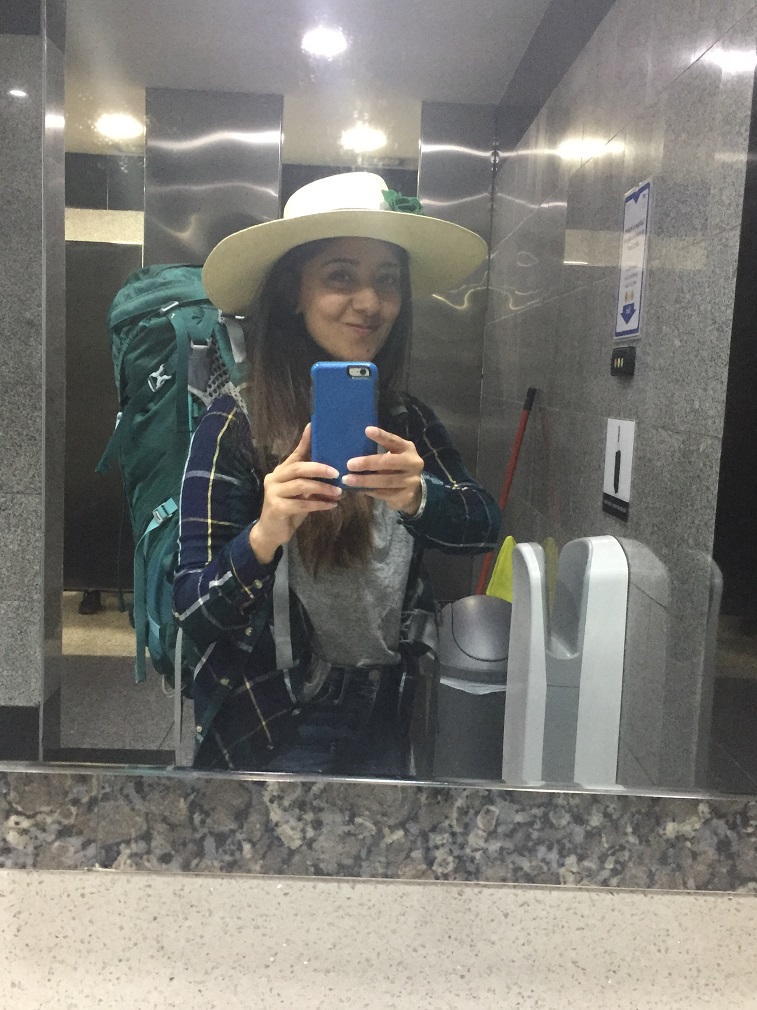
Ravdeep Jaidka is a Sourcing Manager in our Fresh Produce division, and often travels to meet with avocado and banana producers. Her tip is to think carefully about what to bring along.
Visiting each producer partner at source is an important element of EE’s producer relations. Over the years of traveling, I’ve added some essential items to my packing list to keep the trips manageable on a personal level:
Travel Yoga Mat, since the best way to get some exercise can be through some solo yoga in the hotel room.
Instant Coffee Packets. While it’s not the tastiest, it’s pretty easy to get your hands on a cup of hot water to get that daily fix.
Backpacking Pack. Having all my luggage on my back makes me feel more secure and agile while moving through crowded bus stations.
Facial wipes, because it gets sweaty on the farm!
Finally, some pre-downloaded podcasts and Netflix for the long flight.

As manager of the Cooperative Development Program, Julia Baumgartner works regularly with nine different agricultural co-operatives in Mexico, Peru, Guatemala and Paraguay. She offered these travel tips, focused on the importance of looking after your health while on the road.
The key to frequent international travel for me is staying healthy on the road, often in challenging environments. With too much experience getting sick while traveling, I’ve found natural remedies to keep me well and energized. I never leave home without probiotics, Intestinal Tract Defense tincture in case I do get sick, elderberry tincture and oral rehydration. Lately I’ve been careful to produce less waste, and always pack a water bottle, tote bag, reusable utensils, a coffee mug and bandanas.

Kim Coburn maintains relationships with co-operatives across Latin America who grow coffee. She’s Equal Exchange’s Green Coffee Buyer. She contributed some smart travel tips for staying safe – and for not letting the friendly welcome mess up your ‘do!
When you’re a female traveler, it’s smart to have an itinerary planned out and confirmed, and have drivers or a transportation plan to and from each destination. If I’m traveling solo, I make sure that my cell phone will be on and working in case something falls through (hey, it happens)! And I bring a backup charger to make sure said phone stays on!
People of all genders will probably want to bring along a comb, but here’s my tip: it’s really necessary if you have long hair! In some parts of the Andes, it’s customary to throw confetti to welcome guests. While this is a beautiful gesture, it takes forever to get out of your hair — especially after walking around under the sun, visiting farms, and getting sweaty.

Travel is unpredictable! Laura Bechard offers some tips to help you lean in to that uncertainty and enjoy it. She’s our Chocolate Supply Chain Coordinator, and has visited cacao and sugar producers in several different countries.
Don’t be afraid to help out in the kitchen! Some of the best conversations happen over the dinner table.
And always pack a swimsuit. From bathing and hygiene to swimming and fun, you never know when you might need one!
Want to learn more about fair trade? Sign up for our newsletter!
Newsletter sign-up is not currently available.
For many of us, February is a month filled with love…and chocolate. This month, we highlight social justice activist and top Equal Exchange supporter Susan Domey-Allen of UCC Norwell in Massachusetts. Susan recently shared their fair trade story and a variety of ways to reach out to others to ensure sure that purchases of chocolate don’t contribute to slave labor, human trafficking and injustice for cacao producers.
Susan says, ” The United Church of Christ (UCC) Norwell has been active in supporting Equal Exchange since when I joined the church back in 2007. We adopted a Fair Trade program within our Mission & Outreach ministry team and dove in feet first by attending advocacy trainings by Equal Exchange. We then volunteered to staff booths at local UCC meetings and functions locally and within New England.

We have gone from having sales roughly twice a year to sales every month and bringing in an average of $350.00 to $400.00/month. We have named our program the “Fairly Traded Initiative” and are now also getting more involved in community outreach. Volunteers have presented adult education forums within our own congregation, in other churches, and in forums while partnering with the UCC Norwell Human Trafficking Awareness Ministry Team. Here we explain the role of Fair Trade in association with human trafficking victims and survivors (both labor and sexual trafficking).
In the one-minute video, Susan explains how she educates her community about slave labor in the chocolate industry:
In 2016 the Fairly Traded Initiative started being a regular vendor at “Super Saturday’s” sponsored by the Massachusetts Conference of the United Church of Christ. In October of 2018 we presented a workshop entitled Fair Trade: God’s call to Consciousness–Shopping is Mission where the emphasis was on chocolate and educating on what “fair trade” products are.
To expand our community outreach and collaborate with other local churches, the Fairly Traded Initiative organized a Fair Trade / Local Artisans’ Market in the fall of 2017. That year we had 14 vendors representing a variety of global programs many of which represented some form of “fair trade.” In 2018 our second market had 20 vendors and received a full page write up in the local newspaper giving each vendor recognition. Well over 300 patrons attended. In 2019 we partnered with the South Shore Interfaith Coalition Against Human Trafficking to organize our 3rd Market. We had a variety of vendors, it was well attended, and our goal now is to have other churches or venues host the event.
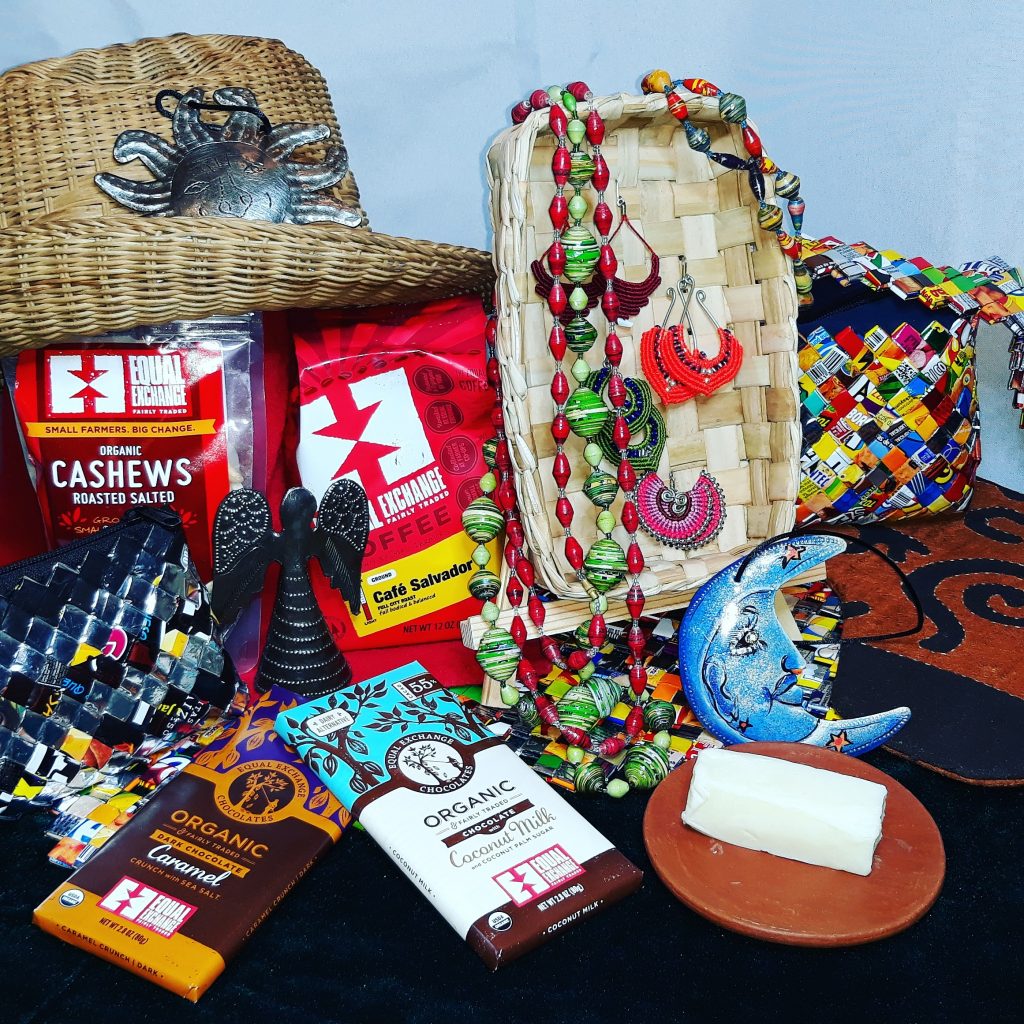
2019 was a year of growth and expansion for the Fairly Traded Initiative. We had booming sales when we partnered with our Human Trafficking Coalition on the day of their forum in church. In February we wrote heart felt cards of gratitude to small farmers as well as highlighting NO child slave labor chocolates.
In March I attended the Fair Trade Campaigns National Conference in Chicago where I represented my church and my passion and commitment to Equal Exchange and justice. For July we partnered with New North Church in Hingham, MA to host a summer Fair Trade cheese & chocolate / organic wine & craft beer tasting. In October we worked with the Quincy Fair Trade Task Force to put on a Fair Trade Market at the UCC Wollaston Church and in November we hosted our own.
The Fairly Traded Initiative is taking a leap in 2020 to expand our outreach to the social media market and involve the global network. UCC Norwell has had a relationship with ASAPROSAR ( Salvadoran Association for Rural Health) a non-governmental health organization in western El Salvador for over 30 years. Our August delegation (which I have been a part of since 2009) spends time in the rural communities with the poorest people. Last year I spent time with many artisans who have utilized the Micro-credit program of ASAPROSAR to develop businesses. Today it is difficult to find a market for their products and they have no means to export them on there own. We are very excited to offer them this opportunity for global market partnership through an E-commerce website. This project would never have been possible if not for my long term collaboration with Equal Exchange and all of the people that I have met on this journey of “fair trade” advocacy.
UCC Norwell is proud to support Equal Exchange and be an active voice and advocate in the drive for justice along the food chain.”
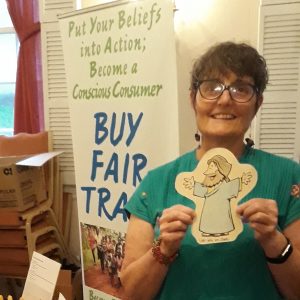
Susan and her team are true activists and superstars in our eyes and we at Equal Exchange are proud to keep cheering them on!
There’s still slave labor in the chocolate industry today?
It may surprise you to find out that slavery and child labor can still be found in the supply chains of major chocolate companies. Cacao (the agricultural product from which chocolate is made) is traded on the global commodity market. The price has dropped abruptly in recent years. But consumer demand for chocolate — especially inexpensive chocolate — has not. When companies are paying less for the same amount of product, that creates a real problem for farm workers. Journalists who cover the chocolate industry have documented labor abuses, including child labor and forced labor. It’s especially prevalent in West Africa, where much of the world’s cacao is grown.
According to a June 2019 article in the Washington Post Hershey, Nestle and Mars could not guarantee that any of their chocolate was produced without child labor. Demand transparency in your chocolate supply chain.
How do you know if your chocolate has been produced without slave labor?
Most major corporations don’t advertise where their chocolate comes from and if the cacao farmers were paid fairly. In fact, we don’t hear them talking about it at all! So if you’re buying from one of the big guys, it’s not easy to answer that question.
We’re different. Equal Exchange works directly with small-scale farmer cooperatives in Peru, Panama, Costa Rica, the Dominican Republic and Togo as part of long-term, fair trading partnerships. Equal Exchange’s products meet the strict standards established by the Fair Trade Federation. This includes no child labor or slavery. We visit our farmer partners in person. We’ve met their families and know their names. We’re proud to connect you with their stories and their high-quality, organic cacao.

What is that again?
Soy lecithin is an emulsifier made from phospholipids and oil derived from soybeans. Many chocolate bars contain soy lecithin because it lowers chocolate’s viscosity and extends the shelf life. Soy lecithin is inexpensive. It’s a byproduct that’s left over after soybean oil is manufactured. Using soy lecithin speeds up the chocolate-making process. That makes it cheaper to produce.
Which chocolate doesn’t have soy lecithin?
ALL of Equal Exchange’s chocolates are free from soy lecithin. Instead of using emulsifiers or fillers, we conch our chocolate the old-fashioned way. We don’t skimp on high quality, organic and fairly traded cocoa butter to make delicious, soy-free chocolate.
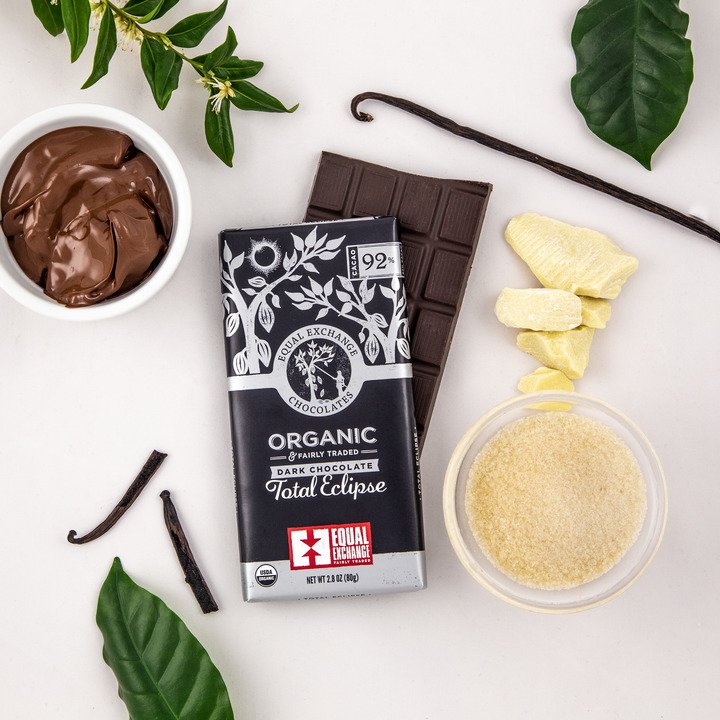
How much sugar is there in some chocolate bars?
We know that consuming a lot of sugar isn’t in our best interest, health-wise. Did you know that a 1.4oz size chocolate bar from a popular brand that rhymes with “Glove” has 22g of sugar per serving? You can choose a treat that isn’t a sugar-bomb but is still delicious.
What kind of chocolate is a good choice for someone who wants lower sugar but great flavor?
Equal Exchange’s best-selling Organic Panama 80% Dark Chocolate Bar has 8g of sugar per 12 piece serving (1.4oz, or half of an Equal Exchange chocolate bar). And sugar isn’t the first ingredient on the label. One reviewer describes it as “velvety smooth, not overly sweet but rich and satisfying.” Another says the bar has a “very creamy texture and full-body taste for a very dark chocolate bar.” Other Equal Exchange chocolate bar choices that are lower in sugar include our 71% Organic Very Dark Chocolate (11g of sugar per 12 piece serving), and our 92% Organic Total Eclipse Dark Chocolate bar (3g of sugar per 12 piece serving). You can find the ingredients and nutritional information on each of our chocolate bars online, Just click on the product and scroll down past the pricing information.

Is there plastic in your tea bag? What about trace amounts of bleach or pesticides? If you’re like most people, making yourself a nice cuppa at home probably involves a tea bag. You dunk the whole bag in boiling water and then allow it to steep until the tea is brewed. You remove and discard it when the tea is done — but it may leave behind more of a trace than you’d guess.
The earliest tea bags were sewn from cloth – usually muslin or silk. Today, they’re more often made from paper, which can be treated in various ways. And plastic tea bags are becoming more common, too. It’s easy to find out what’s INSIDE the bag – tea leaves, or herbs and flavorings. You’ll find a list of ingredients on the box. But manufacturers aren’t required to say how they make the tea bag or what it’s made from.
Have you seen plastic-mesh tea bags? Made with nylon and polyethylene, each bag is roomier than the traditional flat tea bag. What’s the problem? The plastic doesn’t stay put.
A study conducted at McGill University in Montreal showed that steeping a single plastic teabag at standard brewing temperature causes approximately 11.6 billion microplastics and 3.1 billion nanoplastics to be released into the cup (source). What happens to these tiny particles of plastic next? You ingest them – they enter your body along with the tea!
And when you throw away the tea bag, the rest of the plastic goes into the landfill. That’s a problem, too.
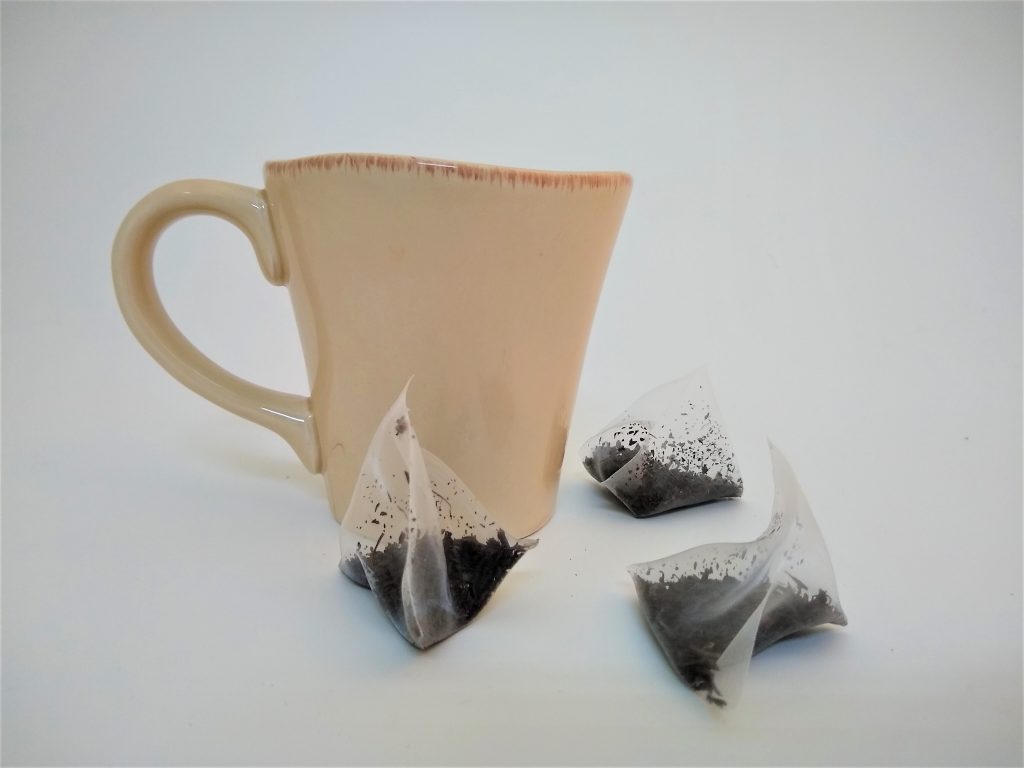
Maybe old-fashioned paper tea bags are starting to look like an attractive option. Paper is made from organic material — wood or vegetable fibers that don’t leave behind microplastics or nanoplastics. So far, so good. But a lot of manufacturers want the paper they use for tea bags to be white. They make that happen through a bleaching process.
Paper-makers use a chemical called chlorine dioxide to bleach pulp. It breaks down the substance that gives the fibers color, leaving the pulp white. Despite the claims of some paper manufacturers, paper bleached with chlorine dioxide is not completely chlorine free – chemicals called dioxins can still be found in the pulp. According to the CDC, chlorinated dioxins have been found in tea bags made from bleached paper at concentrations up to 4.79 parts per parts per Trillion (source).
Another chemical to watch for in tea bags is epichlorohydrin. Some manufacturers are treat their bags with this compound to make them stronger when wet — but it’s a carcinogen.
The tea bag isn’t the only potential source of contaminants in tea. Did you know that tea leaves are never fully washed between the harvesting and manufacturing stages of tea production? Tea is often planted as a monocrop and, if not grown organically, the plants are sprayed with intense pesticides. If the tea you buy is not organic, chemical residue may end up in the cup.
For an unadulterated cup of tea, make sure it’s organic. If you want the convenience of tea bags, look for toxin-free bags that are not bleached with chlorine and are made of natural fibers.
Equal Exchange partners with farmers who grow using organic methods. They use companion planting, natural pest deterrents, and composting to nurture the soil instead of spraying lots of pesticides. Learn more about our tea process here.
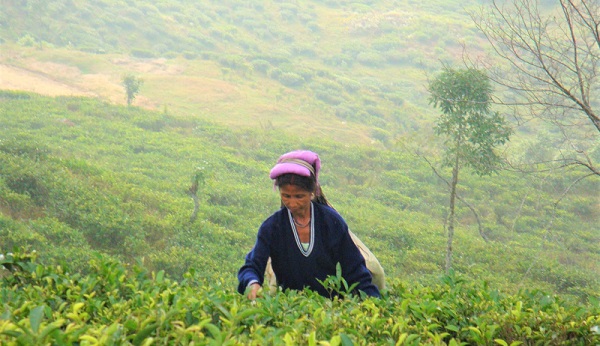
The paper in Equal Exchange tea bags is made from all-natural abaca, a fiber derived from a species of banana plant. Instead of chlorine bleaching, we use a process called oxygen delignification. Our tea bags do not contain epichlorohydrin, nor are they treated with this substance. We’ve chosen an organic cotton for the string of the tea bag. And it’s sewn together — there’s no glue or metal staple to give your tea a funny taste. Equal Exchange’s tea bags are dual-chambered, for a superior steep. Try our range of organic and fair trade teas in green, black and herbal.
.
You want tea in your mug – nothing else!
Learn about food and fair trade — and get first dibs on coupons and special offers! Sign up below for our twice-monthly email newsletter.
Newsletter sign-up is not currently available.
Many of us who eat meat buy it at the grocery store. We don’t know exactly where it comes from or how the animals were raised. And local farmers who are using more humane and sustainable practices don’t know how to reach customers who care. With Walden Local Meat — a meat CSA — Charley Cummings set out to connect customers and farmers. Kate Chess and Gary Goodman talked to him about how his business works.
Listen to our conversation on the first episode of Season 2 of The Stories Behind Our Food!
You can hear #StoriesBehindOurFood on:
If you enjoy our podcast, help us spread the word by sharing on social media! And make sure to subscribe to The Stories Behind Our Food to hear the newest episodes when we release them.
Intro: (00:00)
Everyday grocery store items like bananas, chocolate, coffee — these are global commodities. They pass through a lot of people’s hands on their way from the fields to your grocery cart. This is The Stories Behind Or Food podcast, the podcast where expert guests share insider knowledge about every step along the process. I’m Danielle Robidoux — and I’m Kate Chess — we’re your hosts.
Kate: (00:24)
This is Kate Chess and we’re recording today from Billerica, Massachusetts from Walden Local Meat headquarters. I’m here with Charley Cummings, the founder and CEO — and our producer Gary Goodman is here with me taking over some hosting duties today.
Gary: (00:40)
Nice to be here.
Kate: (00:41)
And Charley, thanks for taking the time to talk to us.
Charley: (00:44)
Super excited to have you guys.
Gary: (00:47)
So Charley, how does grass fed beef work in the middle of the winter? Can you tell us a little bit about that?
Charley: (00:53)
Great question. and it’s a beautiful day in New England out there right now looking out the window. so essentially it’s there are a couple of different things that can happen. So All of our beef are still a hundred percent grass fed and finished even in the winter months. So the way it works in the winter is you can actually graze in the pastures on a day like today where you don’t have a lot of snow cover, assuming, farmers have left that second or third cut of hay in the fields. And cattle can actually, in most cases even graze through a few inches of snow. I’m again assuming that nutrition has been locked in the field, and then outside of that, in this sort of harsher winter months, typically those animals are put on what’s called sacrifice pasture, that you’re not too worried about it trampling the mud and such, and fed cut hay. So it’s essentially the same diet. sometimes that hay is in the form of what’s called haylage, which is sort of partially fermented. But the same core product, it just gives it a little bit, a slightly higher energy value for the, the winter months. But that’s the short story.
Kate: (02:06)
Does a certain kind of hard winter make this more challenging? Or does that system that you described work all the time, every winter?
Charley: (02:14)
it’s a good question. It’s, it’s actually, it’s more difficult to get cattle to, gain weight, particularly on a grass based diet in the summer months than it is in the winter months. So it’s the heat that actually causes them to, not perform well. They’re sort of more tolerant of the cold, at least the breeds we’re talking about, which are typically like an Angus cross.
Kate: (02:36)
I would not have guessed that. That’s really interesting.
Charley: (02:38)
Yeah.
Kate: (02:38)
So you’re speaking about this very knowledgeably. Do you have a farming background yourself?
Charley: (02:44)
No. A couple of years back, gosh, now, like six years ago, my wife and I– well, let me go back a little further. So my then-girlfriend and I moved across the country, lived in San Francisco for a couple years, spent a lot of time in California’s Central Valley. I was in — at the time in the composting business. So that’s really where I got to know the agriculture, agriculture, world.
Kate: (03:09)
America’s salad bowl.
Charley: (03:10)
Yeah. So if you guys have ever looked at a satellite map of the U S there’s like this beautiful bright green neon Crescent in the Central Valley, and this is like the Grapes of Wrath. What was once the dust bowl? But it’s now one of the most agriculturally productive areas in the whole world and produces like, actually I was just reading the other day, it’s 99% of the world’s almonds. 80 — not almonds, I’m sorry. walnuts and about 80% of the almonds and then 40, 50% of pretty much you name the sort of cash crop category like tomatoes and specialty, produce and stuff.
Kate: (03:59)
Strawberries out there, right?
Charley: (04:01)
Strawberries, raspberries, yet and yet, It is sort of teetering on the edge of failure. So somebody turns the water off and that whole Valley becomes the Dustbowl again. And someone turning the water off is not just a, a figure of speech. I mean the water rights out there, really, really big problem. So anyway, I just found it really fascinating to be out there. I spent a lot of time with folks that had composting businesses there. And that was really my, first exposure to the industrial agriculture world. Of course, there’s a lot of protein produced in the Valley too. so a lot of cattle feed lots, a lot of, commodity pig farms. And if you’ve ever driven by one of these things, just like, the stench, I can’t imagine living within, you know, few miles of them. So that was really my entree into, into agriculture. so we ended up, we moved back East, New England is sort of home for both of us. We got married, she, two of us read a few books together that, maybe romanticize small scale New England farmering a little too much. and she decided she was going to work on a farm that summer after we moved back. And it was just, you know, going to be just this summer. And that just this summer sort of turned into, five years or so.
Kate: (05:36)
And this was both of you or just her at that point?
Charley: (05:41)
Just her, I still had a normal job. but, she was very much inspiring in that way. So That was really where Walden was born out of is seeing a lot of folks and meeting a lot of folks, by virtue of my wife who are in New England farming that seem to be doing everything right from the sustainability and animal welfare and a soil health perspective. But weren’t really in a position to start selling their products to the sort of main line distributor or anywhere else. so there was sort of a missing link there. so that was really, that was really the Genesis.
Kate: (06:26)
Yeah. And I think there’s an inherent irony. You have “Local” right in your name and you’re working with local farmers. And so if someone is to be a local farmer, they can’t expand too far or they won’t be local anymore. They’re going to be huge. So it’s like putting together lots of pieces for a lot of different farms.
Charley: (06:49)
Yeah, totally. I mean, I hope that that’s the one — well not the one. Hopefully that’s one of many things we’re doing that are valuable. but that feels like the primary one is like, you’ve got this really big complicated, fragmented supply chain of individual, family farmers. so I was just looking at these statistics the other day. We work with about 75 different partner farms. and the average size of those farms, is something like 250 acres. The largest of which is, maybe 2000 acres. And there’s, there’s only a couple that are over a thousand acres. So it’s, it’s really difficult to find contiguous acreage much larger than a thousand acres in the area.
Kate: (07:37)
Yeah. What is local? How do you define local?
Charley: (07:41)
Yeah. we talk about it as, States. So we work in New York and New England and we really don’t get to the Western half of New York, but that for us has felt like the most meaningful thing, to consumers as opposed to some sort of arbitrary. You know, radius. Just thinking about like, this is from my state or my region.
Kate: (08:04)
Yeah. That makes sense.
Charley: (08:06)
I realize I didn’t like really explain what we do or what the —
Kate: (08:10)
Yeah, tell us about your model!
Charley: (08:13)
So we work with, area farms that produce 100 percent grass fed beef, pasture-raised pork, chicken and lamb. we do a handful of other things like grass fed butter, eggs, and some ancillary products too. and we take those products to our member families that live from central New Jersey all the way up to Portland, Maine. And we sort of handle everything in between. So we sell our products in what we call a share program. So if you’re familiar with, like a vegetable CSA, we’re very much modeled on a similar type model. So we buy exclusively whole animals and then Break them down into the, into parts and pieces that are distributed amongst our member families in the form of a share. So you sort of get a different mix of cuts each month. Ah, so we do once a month deliveries and then there’s opportunity to add cuts as you like to your core share. Does that make sense?
Kate: (09:19)
Yeah.
Charley: (09:19)
That’s the short story.
Gary: (09:21)
But it’s a little different than like a traditional CSA, right? Because you are shipping it to doors, where a lot of times the CSA is, people might come and pick it up? I guess sometimes people get them shipped too…
Charley: (09:31)
Yeah. So when we, that’s actually, that’s a great point. So when we first started, my wife and I were in another meat CSA, in an adjacent farm to the one that she was working at and the experience was just ah, tough. Like we found it, for example, incredibly challenging to arrive between, I think it was like 10:00 AM and noon every other Saturday or something for the pickup. And I mean, we didn’t have kids at the time. We weren’t even that busy and it was just like impossibly difficult for us to remember to do that at that time. So it felt like a delivery was a really big deal to getting over that barrier. There were also a lot of issues we had with not just the convenience aspect of it, but the consistency of the product or the quality of the product. The cutting. And so it felt like there was, a need there because we had all these farmers that, would love to get their product out to more people, but for them, the marketing and distribution and inventory management and the customer service and all this stuff that we try to do, it’s typically not an area of interest amongst our partner firms and, and not really a core skill set either. So hence where we come in.
Kate: (11:07)
Yeah. Scale. It makes sense.
Charley: (11:08)
Yeah.
Gary: (11:09)
I mean, what would you say makes, like if you were to talk to the audience, what makes this better then like going into a supermarket and just picking up a steak? Like Stop and Shop or something?
Charley: (11:26)
Yeah, great question. So know I think, I think we’re trying to align around the idea that we are just trying to sell the absolute highest quality product you can buy. And to us that means it’sconsistent in terms of flavor and taste and, cut quality and all of that. And what allows us to make that promise is this direct relationship with local farms that are committed to the same ideals of sustainability and and, regenerative agricultural methods. so things like rotating animals through the pasture on a daily basis, being committed to the health and fertility of the soil. 100% grass fed and finished beef. So they’re not — no grain feed of any kind. There’s no manure lagoons at our pig farmers’ —
Kate: (12:30)
Good to know!
Charley: (12:31)
There’s no, there’s no, you know, waste disposal issues when you’re raising animals out in the pasture. So all of those things sort of add up to, a product that has a different nutritional profile, a different taste. And we think overall just sort of flat out a higher quality than a product you could find in the, in the grocery store.
Gary: (12:57)
And presumably like this is better for the farmer as well. Right? Like, working with you guys.
Charley: (13:03)
It’s definitely better than for the farmer. So, by way of comparison, the average farmer takes home about 10 or 11 cents of the retail dollar. And, and our farmers and butchers together take about 55 cents of the retail dollar, With the farmer being the lion’s share of that. And so it’s definitely better for the farmer. Our farmers too, they have restaurateurs all the time coming to them and saying, Hey, I’ll buy all of your sirloin steaks or all of your strip loins, you know, name your price. For the smart farmer, that’s sort of like a fool’s errand because they don’t, they don’t sell strip loins, they sell cows or pigs.
Kate: (13:48)
Right. What happens to the rest of the animal?
Charley: (13:51)
Exactly. So I mean that’s our whole business. We talk about sort of operationally, we’re whole animal in whole animal out. So the whole animal comes in one door and the whole has got to go out the other door. So we make a lot of effort to balance the whole carcass and do things like raw dog food and dog treats and different organ blends and such. and, you know, really try to maximize the value of all the parts and pieces and that helps to deliver more value to a farmers who in our view are again, really doing everything right from a sustainability and animal welfare perspective.
Kate: (14:32)
Do you think there’s a complete correlation between sustainability practices that are the best for the animals and the taste of the meat?
Charley: (14:41)
Oh yeah, totally. Okay. I mean, just anecdotally, I wish I could show you some pictures while we’re sitting here, but, I typically show them to people when they first join the company of like what an industrial pig facility looks like. For example, it’s sort of the equivalent of like, imagine what your health outcomes would be if you were basically just sort of couldn’t sit up from your couch and were fed potato chips all day. And so if you don’t think that’s the right sort of healthy environment for you to be in, why you would think that you would get good health outcomes from eating an animal that was raised in those conditions, is, yeah. Is is sort of anecdotal way to think about it. I think more, more sort of quantitatively, there’s a lot of good research out there, particularly on there carbon aspect of that. So White Oak Pastures is a, farm down in Georgia that is, sort of amongst the leaders in this sort of whole regenerative movement and they you know, recently did a super interesting third party study demonstrating that, when you raise animals regeneratively in this way, you actually from a carbon impact perspective, it’s not just better than conventional beef for example. It’s also better than all the sort of fake meat alternatives out there. And beyond that it’s sort of beyond this idea of, doing less harm. It actually has a net negative carbon impact. So these are activities that — that’s why we use and more people are starting to use the word “regenerative” because it’s not, it’s not the sort of old environmental axiom of doing less harm. It’s actually a net positive benefit.
Kate: (16:49)
Where does the net positive carbon come from?
Charley: (16:53)
Yeah, yeah. Good question. So, it’s in the carbon sequestration in the soil itself. So yeah, when you re when you raise beef in a feed lot, you need to feed them and they’re so, confined in a concentrated area that there’s no way you could grow enough food in the area that they’re standing to feed them. So you have to import feed from somewhere else. You also have to fertilize that, feed with something because we tend to grow it in monoculture. It’s corn and soy we’re talking about. So you’ve got to apply synthetic fertilizers. Herbicides and pesticides too. Make the yields make sense. So you’ve got a feed problem and then a fertility problem. And then also in these tremendously concentrated conditions have this waste disposal problem. So that’s where you get these manure lagoons that, you know, following Hurricane Florence for example, North Carolina is a big pig production state. These things overflow. Now you’ve got like — I mean, floods really suck, but toxic floods are like, great. Yeah. That’s like really bad news. so these things overflow. It’s a problem. So in a traditiona — I shouldn’t even say traditional because that’s giving it too much credit. In the industrial commoditized world, in a feedlot setting, you’ve got these three distinct problems that we look at and solve them each individually. We’re going to import the feed somewhere else to grow the feed. We’re going to use these artificial fertilizers, herbicides, pesticides, and to dispose of the waste, we’re going to develop our own really, really bad septic system right next to this feedlot. Compare that to grass fed, where you have an animal out in the pasture. So the feed problem is the pasture itself. They’re eating the feed, it’s available to them in the pasture. There’s no manure lagoon because the waste that they’re creating is immediately trampled back into the soil. And it’s what provides the fertility for the pasture, which is the food that they’re eating. So there’s no three distinct problems. There’s one sort of symbiotic cycle. And what breaks that cycle is when you keep the cattle on the same ground for too long. So it’s rotation through the pasture. Typically they’re moved every single day. That is sequestering the carbon in the form of the waste that they’re trampling back into the soil. Now where you get a huge benefit is where you put chickens in cows on the same pasture. Chicken waste is very heavy nitrogen. Cattle waste is very heavy carbon. That’s where you get this nitrogen fixing in the soil. And that’s where the, that sort of doubles the carbon sequestration impact. So we have a handful of farms that do multi-species like that and we’re trying to encourage more folks to do more of that. Whew. That was probably more than you guys wanted …,
Kate: (20:20)
No, it’s really interesting. I think that’s beautiful. What’s the — is there like — so you’re talking about whole animals in and whole animals out and that’s really great. Are there — I was interested when you talked about chefs approaching farmers and saying, we just want your sirloins. What’s the hardest part of the animal to deal with? Is there a learning curve for customers? Do you give them weird stuff they may not initially know how to appreciate that they have to figure out?
Charley: (20:44)
Yeah. Great question. So organs are typically — not typically are always excluded from the share. So there are folks that want that sort of stuff and they, they buy them separately. So it’s really on us to balance that sort of stuff. There’s also, another way to think about it as I’m on a typical beef carcass, that carcass is about 45% ground beef. People don’t realize it. It’s like half is hamburger. And our shares are not half hamburger. So we have a lot of interesting food service, like university partners that are big buyers of ground beef. That’s typically the challenge most people would say in the industry is, is the trim. And the reason is because the dairy industry, almost all of the ground beef you’re eating in the supermarket is from dairy cows.
Gary: (21:42)
Really?
Charley: (21:42)
Yeah.
Kate: (21:42)
Something I didn’t know.
Gary: (21:43)
Yeah, that’s a …
Charley: (21:45)
Fun fact. and so as a result, there is sort of theoretically more ground beef out there in the market then there should be, which means that I can get out the chalkboard and walk through the math if you really want to get into it. But it means that the ground beef on an average beef carcass sells at a price that is typically below the weighted average cost of the whole thing. So put differently, the middle meats pay for the whole operation. And you know, we’re not too dissimilar to … from that.
Kate: (22:26)
That makes sense. Yeah. Yeah. So you don’t fob this stuff off on your customers. You have other customers separate from your shareholders who take the organs off your hands and who buy the ground beef. You’re not going, you’re not going to have a situation similar to the vegetable CSA where you just get rutabagas for months.
Charley: (22:44)
Definitely not. Definitely not. That was something, you know, we really wanted to solve early on was how do you figure out a balance that, you know, sort of optimizes the whole carcass while meeting everyone’s preferences and such. And interestingly enough, I don’t know that I believed this was going to be true, but it’s largely true for, for every person that, you know, hates chicken breasts, there’s another person that loves them. Chicken breasts are an easy example.
Gary: (23:17)
Can you tell us a little bit about the actual operation itself. So the, the butchering and the packing and the delivery and how you get it to customers. And just a little bit about that process foryou guys.
Charley: (23:33)
Yeah. So, Typically we’ll have sort of rolling contracts. so we have a commitment for a certain number of animals per month. From what, you know, an active farm. We helped to coordinate the logistics of getting those animals to the slaughterhouse at the appointed time. And just to give you a sense of scale, so, a typical industrial slaughterhouse for beef for example, Might do anywhere from 10 -20,000 head in a single day.
Kate: (24:09)
Do they run 24 hours?
Charley: (24:12)
Typically they would, they’ll do two, they’ll do three shifts. So they’ll do two distinct shift in that cleaning shift. so yeah, a lot of those plants are, they’re not slaughtering 24 hours a day, but it’s open 24 hours.
Gary: (24:25)
Something’s happening 24 hours a day.
Charley: (24:31)
Relative to, you know, our local comparison, you know, our partner processors will max out at anywhere from, 20-50 head in a day. So just like a totally different order of magnitude.
Kate: (24:48)
Off by a thousand.
Charley: (24:50)
Yeah. Very different scale. Yeah. So that allows for quite a bit more individual attention for the animal, which we think leads to different animal welfare outcomes. And it also yields differences in cut quality. So typically in an industrial slaughterhouse you wouldn’t be breaking things all the way down to retail cuts. So it’d be shipped in primals and such. But there’s still a lot of messiness that can occur, right at that level that affects the quality of the final product. But essentially, you know, things are broken down. Our specifications brought back here to our fulfillment center. We sort of pick and pack out of here and then run our own delivery trucks out of here to all of our member families. The pick and pack side of that is crazy complicated in terms of, how the animal is balanced. So we have a handful of algorithms trying to balance th — you know, what comes in a carcass against everyone’s preferences and what they’ve gotten historically and all of that. so that’s, something we’ve developed over a long period of time that I think is like on the technical side of the things we do, one of the more interesting, and it’s because like I said, that the, if the core equation is whole animal and whole animal out, we got to get really good at that for a good customer experience basically. Yeah. So for example, if you got, I mean the idea of is working properly is if you got flank steak this month, you don’t get it next month and somebody who hasn’t had flank steak for a while is more likely to get it.
Gary: (26:36)
Makes sense.
Kate: (26:39)
At what point did you need that? You started in 2014. Is that right?
Charley: (26:45)
We did a small pilot program of like 50 families in November and December the year before. But yeah, we opened at the public in 2014.
Kate: (26:53)
I’m just trying to imagine how this would work at a smaller scale than what you’re currently, so it makes sense to me now. But I’m trying to imagine you starting out and making all of this work.
Charley: (27:04)
Yeah. So I got this really smart idea that it didn’t make sense to pack the shares beforehand and I was just going to pack them in the back of the van. So I had this refrigerated van and then I would drive to these people’s houses and in their driveway or in some cases in like a inappropriate parking spot, blocking traffic. I would get into the back of the van and then sift through these boxes …
Kate: (27:35)
Trying to remember who had flank steak last week!
Charley: (27:37)
Yeah, exactly. And it’s all sort of written on wet paper that’s like, ripping. And I didn’t have a digital scale. I had like an analog fish scale with a hook. And so it would like you, you put, I would put the stuff in the bag and then hang it on the fish scale and then you’ve got to wait like 10 seconds until it settles on a weight. And then it’s like, Aw man, I’m half a pound over. I gotta start all over again. And it was literally like 20 minutes while I’m sitting in the back of this van. And so people would come out of the house, like knock on the door, like, is everything okay in there? And I’m like, yeah, it’s fine! Stay outside. I’ll be right out. So yeah, there was some mishaps, misdirection along the way.
Gary: (28:26)
Like, you’re not butchering it in the back of the bed. Right?
Charley: (28:32)
I mean, there was maybe a point at which I considered that too, but, you know, missteps along the way, I guess.
Kate: (28:41)
Where would you like to see the meat industry in 10 years since you’re a business that depends upon being local. I don’t imagine that you want to take over the whole country, you, but like, what do you think would be a good thing that could happen?
Charley: (28:56)
That’s a great question. I’d like to see, I’d like to see people eating less meat, But feel really great about the meat that they’re eating. And so in some cases, that does mean spending a little bit more, on a per unit basis. But keeping your sort of overall meat budget the same. And I think your dollar goes further, certainly from the farmer perspective and from the ecological environmental welfare perspective, if thought about in that way. So, the way we think about that in the region is maybe a little bit more ambiguous of just contributing to this agricultural Renaissance that’s going on in the region. I say this all the time. But the average age of farmers is declining in the region. The size of farms is declining.
Kate: (30:04)
Which yeah. In case people don’t know, in general, we’re hearing always about a trend of farmers getting older and older.
Charley: (30:11)
Totally, everywhere else in the country. That’s, that’s the case. And the number of farms is increasing. So this is the only region in the country where all those indicators are going in what I see to be there, right direction. So, you know, our, our vision is just to continue to build on this community of people that want to contribute to that. So, we think that this region of the country is uniquely suited to do that for the reasons I talked about in terms of the soil suitability and climactic suitability. And then you’ve also got this massive group of people that live in the surrounding metropolitan areas, that seem to be moving along the spectrum towards more local, more whole real foods. and so combining those two that’s sort of continues to be our vision of a more sustainably fed region. And then beyond the sort of medium term, there is definitely the potential for the Northeast to feed itself from a protein perspective. And so if we had to align around any sort of longer term grandiose vision, that would probably be it. It’s like, can, can this region actually produce enough protein to support, you know, the entire greater Boston area, the entire New York city, greater Metro area. Because we, we definitely think the answer’s yes.
Gary: (31:49)
I mean, is there anything else? I guess the only other parting thing is, is there anything else you want to talk about or say or any story you want to tell?
Charley: (31:59)
I think one, one area I didn’t touch on is just, yeah, one of the problems with the industrialized food system is that when you use your food dollars at the grocery store, the impact of those choices are somewhere else and on someone else. And they’re sort of out of sight and out of mind. And that disconnect causes a lot of problems, a lot of environmental problems, a lot of ecological problems. And frankly, regardless of your politics, a lot of political problems. Because in the absolute, you go too far down this spectrum and you end up with something that looks like Hunger Games, where you’ve got these rural sectors sort of toiling on behalf of this urban sector that, and there’s very few paths between them. And so that’s a core part of what we do is trying to better connect rural and urban. Because when you have that connection and you see the impact of your food dollars and the stories of the farmers that are working every day to produce the highest quality food that they can, you tend to make choices that better support the surrounding ecological environment. You tend to make choices that result in better outcomes from an animal welfare perspective. And it’s maybe to boil it down like you don’t, it was about, I don’t want to use a a bad word, but you know, you don’t, uh …
Kate: (33:47)
This is an R-rated podcast, we’re all adults here.
Charley: (33:52)
Okay. Well you typically don’t just, you know, go to the bathroom in your backyard. And so it’s the same situation of like, if it’s within your own community and there’s people you have a sort of, a sense of who they are, the impacts are just much closer to home and you sort of take care of it.
Kate: (34:13)
Yeah. You you feel like you have a stake.
Charley: (34:16)
Totally. And not to mention the fact that like, I think this is a really special part of the world. Attachment to place has always been really, really important to me and I’m sort of like a New Englander through and through and that makes it, all the more special for me to like try to build a business that’s impactful in the region. And I would love for people to share that appreciation for, you know, what, what this region is about and why it’s special relative to every other region in the world. And there’s a lot of things we do that I think that support that vision of, of New England’s future.
Kate: (35:05)
Thanks so much for spending this time with us sharing your expertise.
Gary: (35:09)
Appreciate it. Thank you very much.
Charley: (35:11)
Thank you guys for coming. Really nice to meet you.
Outro: (35:17)
Thanks for listening to The Stories Behind Our Food podcast by Equal Exchange, a worker owned cooperative. Love this episode? Please subscribe, rate and leave a review. Be sure to visit equalexchange.coop to join the conversation, purchase products and learn more about small scale farmers and the global supply chain. This episode is produced by Gary Goodman with hosts, Kate chess and Danielle Robidoux. Join us next time for another edition of the Stories Behind Our Food.
Do you really need another reason to include more chocolate in your life? Hosting a chocolate sale can help you earn money for your group while offering decadent, organic chocolate bars. In addition to making people very happy, you’ll also be raising awareness about the importance of choosing ethical, slave-labor-free chocolate. You’re only 5 steps away from a successful chocolate sale!
Chocolate is certainly a welcome offering any time of year, although we find that it works well to time your sale around chocolate-centric holidays where people are looking yummy treats and gifts. We recommend planning a chocolate sale near Valentine’s Day, Mother’s Day, Easter or Passover, Halloween, World Fair Trade Day (May 9th), or during Fair Trade Month (October). Pick a day you know a lot of people will be around. Once you have the date set, it’s time to let people know. To help you promote we’ve created posters, social media graphics and an e-newsletter template.
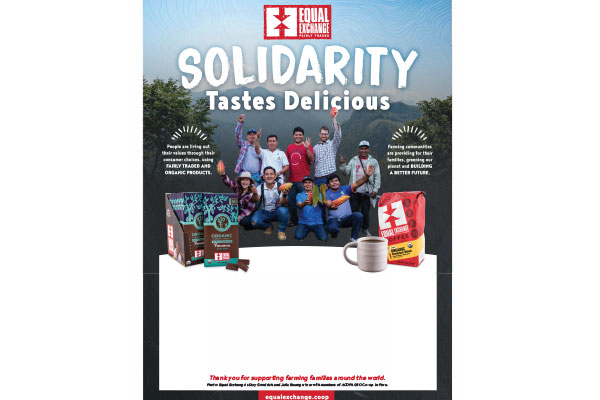
List what payment methods you’ll accept so people will come with cash if that’s what you’re accepting. Here are some additional graphics that you can use to create your own promotional materials. You can further educate potential buyers about how Equal Exchange’s fair trade chocolate supply chain is different than most by sharing this infographic on social media.
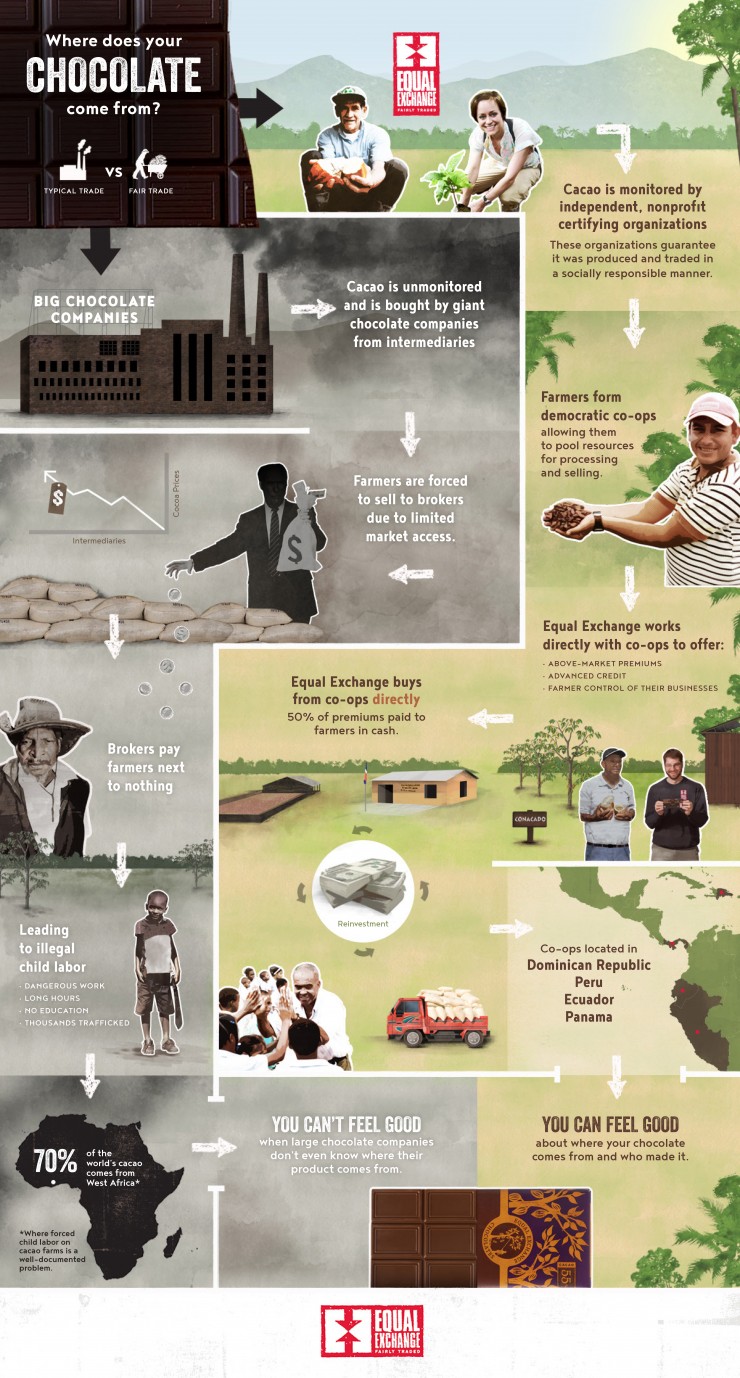
Setting your sale date will also let you know when you need to order from Equal Exchange to receive your chocolate in time. We recommend leaving at least 10 business days between the time you order and when you want your shipment to arrive.
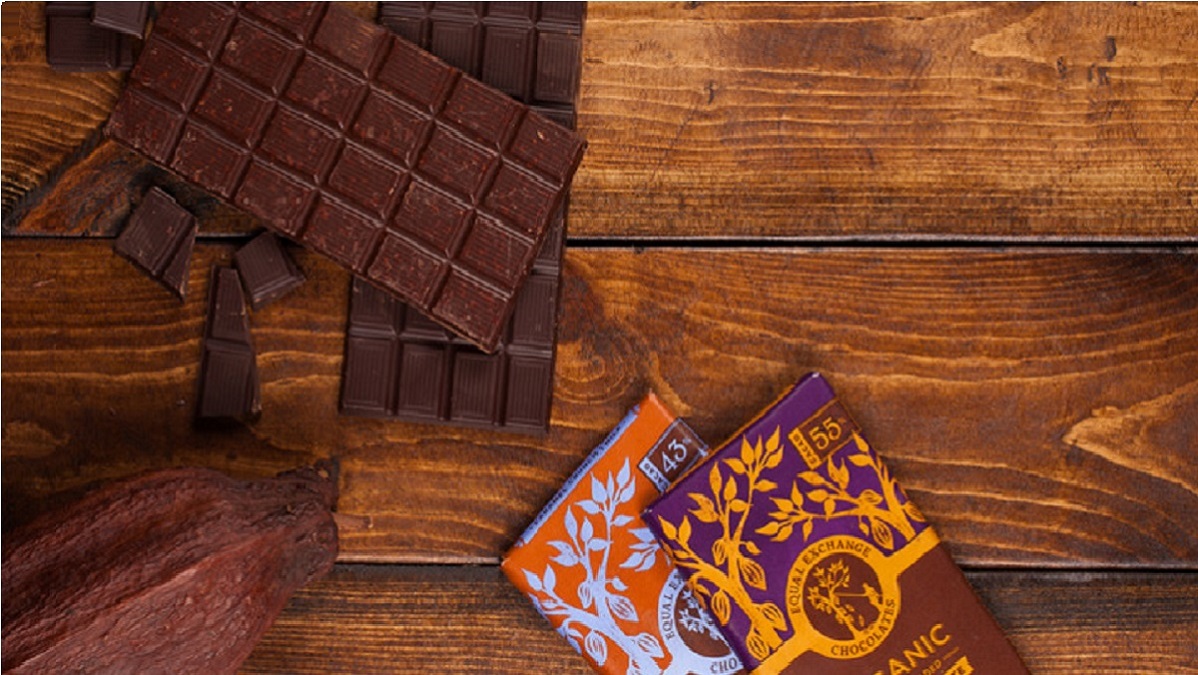
Offer a variety that will cater to chocolate fans of different tastes.
For the dark chocolate lovers: Panama 80% Extra Dark Chocolate, Very Dark 71% Chocolate. Dark Hot Chocolate Mix
For those with a sweet-tooth: Dark Chocolate Caramel Crunch with Sea Salt, Coconut Milk Chocolate, Milk Chocolate. Milk Chocolate with Caramel Crunch and Sea Salt, Hot Cocoa Mix
For those with adventurous tastes: Dark Chocolate Lemon, Ginger and Pepper, Spicy Hot Cocoa Mix, Total Eclipse 92% Dark Chocolate, Coconut Milk Chocolate
Classic chocolate choices: Dark Chocolate with Mint Crunch, Dark Chocolate with Orange, Milk Chocolate, Hot cocoa mix
If you want to sell bite-sized dark chocolate minis, buy them in bulk and sell them individually each.
Here’s our full wholesale product list so you can see all of the options.
Order online or call the order into our Customer Service Team at 774-776-7366 9-5 Eastern, Monday-Friday.
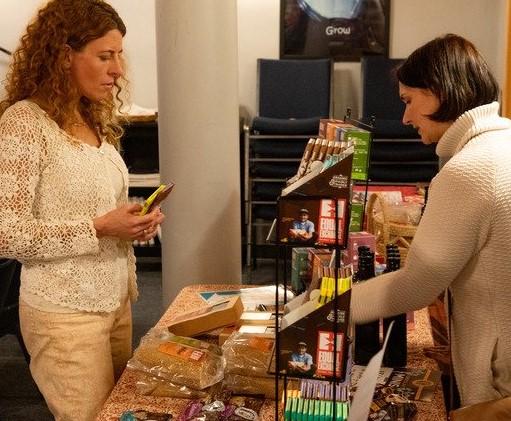
Because chocolate is a consumable product we’re unable to sell on consignment for safety and quality reasons. Purchase only what you are confident you can sell through before the best-by dates.
Choose some add-ons to liven up your display like posters, chocolate pamphlets, a sale poster and Power to the Farmer stickers.
View additional downloadable educational resources here.
When you buy by the case of 12, each individual chocolate bar costs you $2.58. But you can charge $5 a bar depending on your fundraising goals. If you’re not looking to raise any funds but just cover the cost of advertising materials and samples, charging $3 or $4 is a fair price. You can even pre-bundle a variety of five different bars and sell them for a reasonable multi-bar rate.
Cocoas are $34 per case of 6, so $5.67 each. Charging between $6-$8 is a guideline that you can use, depending on your goals.
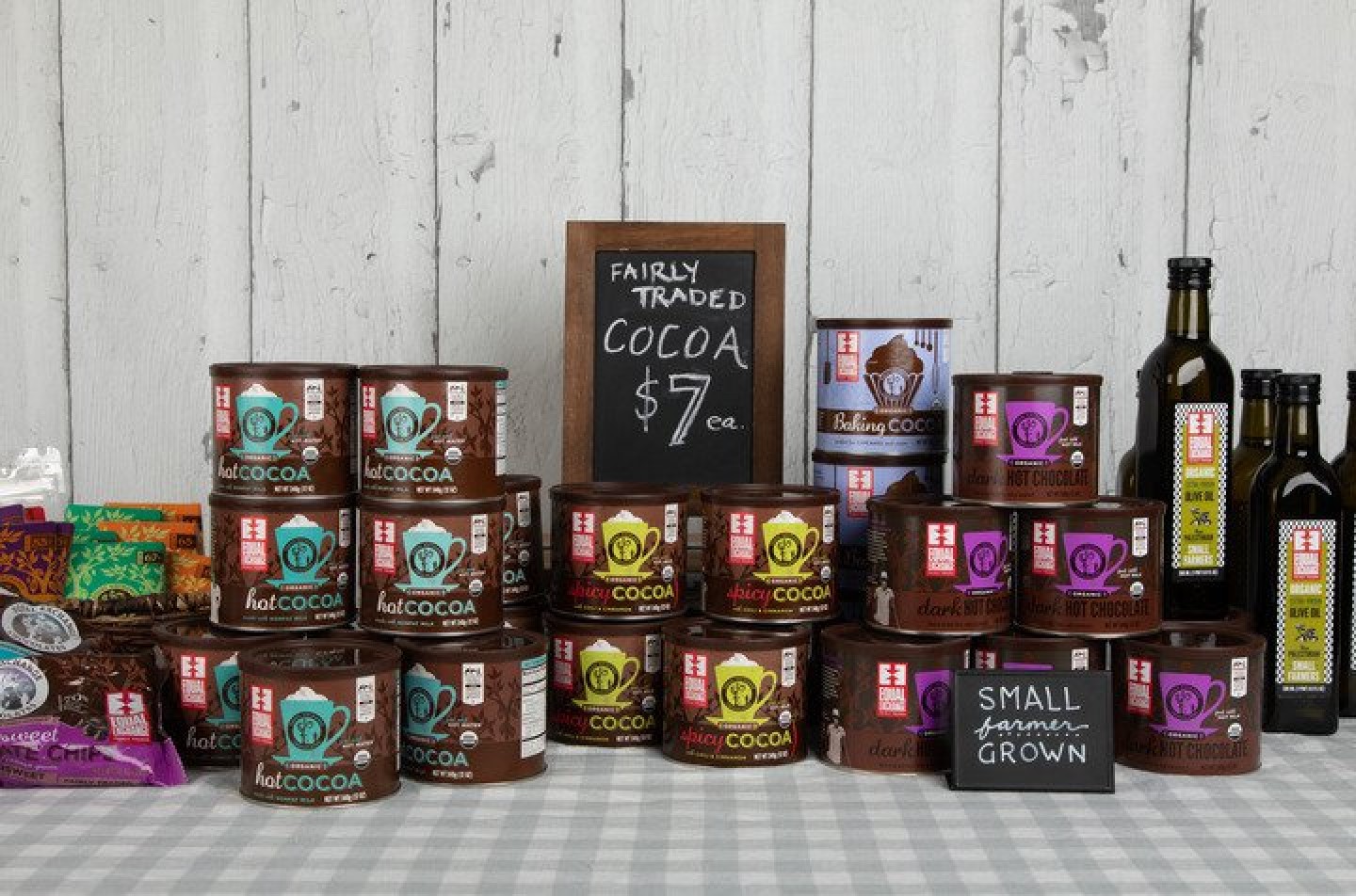
Calculate how many cases you’ll need to sell to reach your fundraising goal.
Then use this handy product and price list template to input your specific sale items and the coordinating prices.
Based on your mark-up, you can figure out how many bars you can spare for sampling and still make your profit goal. When people sample something, they’re more likely to want to buy it! Put out tongs and a plate of bite sized pieces for people to try. Place the bars for sale right by the sample so people can find everything easily. Consider posting allergen information near the sample (ie, contains nuts, dairy, etc) for safety. Many of our chocolate bars are vegan, and all are gluten-free and soy-free.
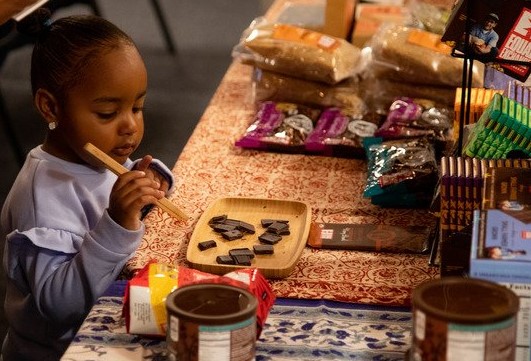
Sampling will help you in another way — you’ll have conversations about what people like best and you’ll know what to order next time!
Set up a hot cocoa bar and sell customizable cups of cocoa
Host a chocolate and coffee pairing event
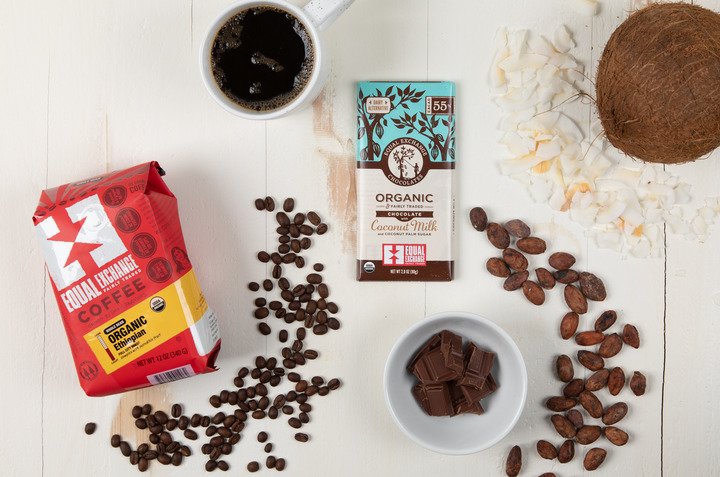
Give an educational presentation (<— under Video and PowerPoint) on how cacao is grown and why fair trade chocolate matters
Organize a chocolate tasting and end it with a chocolate sale
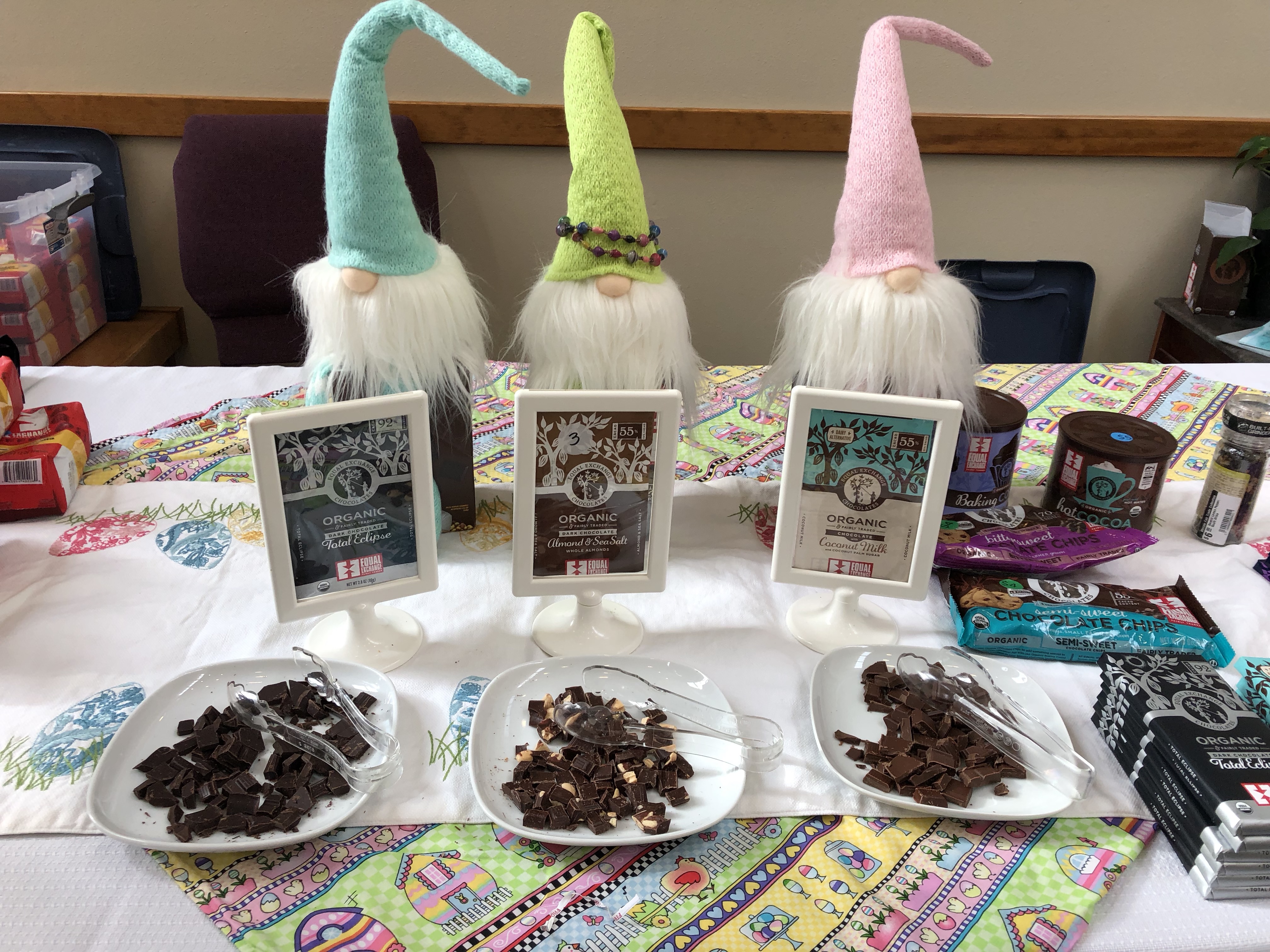
Why does the cup of Joe to-go you buy from that chain or local coffee shop taste so good? One reason might be the freshness of the beans. Those coffee shops serve a lot of coffee. The beans they use are ground every day and never have time to go stale. Freshness makes a huge difference in the taste of a cup of coffee.
If you’re brewing at home, whole bean coffee often delivers superior flavor. Why? When properly stored, pre-ground coffee stays fresh for just 3-5 months, but whole beans will last for a whopping 6-9 months. Order it in five pound bulk bags and grind just what you need, when you need it. You’ll taste the difference!
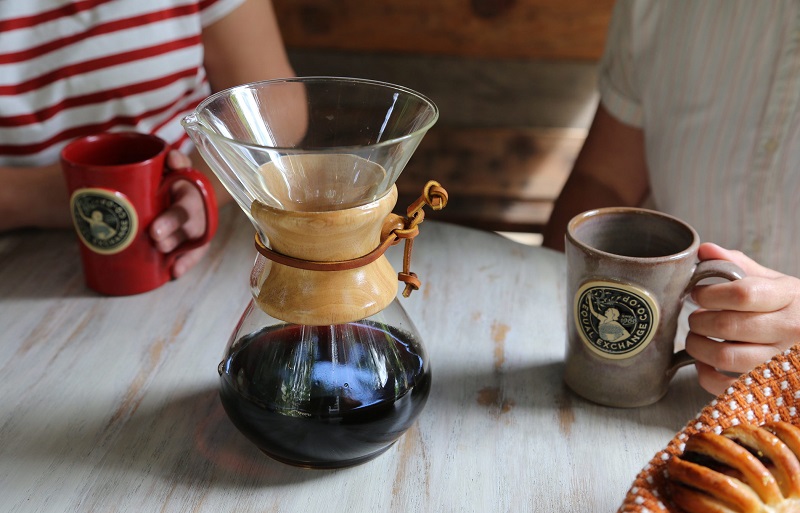
Equal Exchange roasts coffee at our headquarters and ships it out to cafes and specialty grocery stores all over the country – and to savvy customers. When you order directly from us, you’re getting high-quality beans that have just been roasted, not some batch that’s been sitting around at a warehouse. And there are lots of options to choose from!
Try an exciting single-origin or a new roast level. Or a fantastic new blend. Or even a limited edition seasonal from our Women in Coffee series. These coffees were created with cafes in mind, but you can enjoy them at home too, in bulk. The full range just isn’t available in our smaller retail packages.
The word “bulk” might conjure up a ridiculously giant package on the shelves of a buying club or discount store. But our bulk bags are five pounds – totally human-sized. Why buy that much? You’ll save money and waste less packaging.
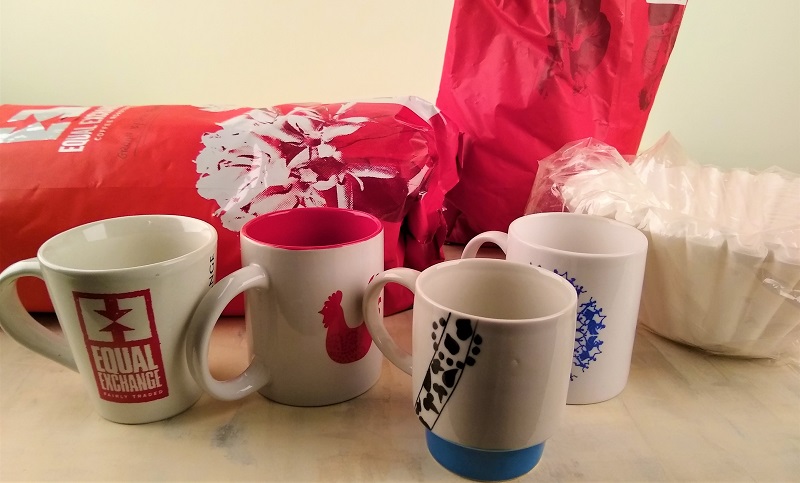
Let’s do the math. Let’s say you like Love Buzz. You can buy a 2-pack of bulk bags for $89.00 for 160 oz of coffee. That’s 56 cents an ounce. If you buy a single 12-oz bag off the shelf at a store, you’ll likely pay between $8.50 and $10. That comes out to 70-83 cents per oz.
That’s not the only savings. Coffee needs to be preserved from light and air to stay fresh. That means an airtight bag with a one-way valve. Bulk coffee means fewer bags — one bag for every five pounds of beans, instead of six bags — so it’s a win for the environment, too.
To us, good coffee means coffee that’s grown by people who can make a fair living from their crop. We pay farmers a fair price, and we’re proud to share their stories – including innovations in their practices to involve youth in farming, preserve biodiversity, and diversify income to improve their communities. All Equal Exchange coffee, bulk or no, is fair trade.

Want the longest shelf-life and freshest taste? Preserve your beans from light, air and moisture. Read more about how to store coffee the correct way.
Want more tips from the coffee experts? Sign up for our newsletter:
Newsletter sign-up is not currently available.
No dessert celebrates the holidays, friends, and family quite like a pie! Equal Exchange’s chocolate supply chain coordinator, Laura Bechard, can attest to that. She grew up in the pie business and from an early age was rolling out pie dough, crimping crusts, and piping whipped cream at her family’s restaurant. The Norske Nook is a quaint family-style restaurant with several locations in Wisconsin. It thrives on the small-town crowd and its regulars who enjoy it for the comfort food and warm coffee. Over the years, it has gained quite a reputation for its stellar, homemade pies, and now attracts tourists and travelers who go out of their way to make a pit stop for pie.
A few years ago, the Norske Nook began using Equal Exchange’s Organic Baking Cocoa because restaurant owner Jerry Bechard noticed that it adds a richness and depth to their chocolate pies that couldn’t be tasted with conventional cocoa powder.
One of Laura’s favorite recipes from the restaurant unites her love of pies with her passion for sustainably sourced chocolate: Death by Chocolate. The chocolate cookie crust, chocolate cheesecake base, and chocolate pudding make a delectable triple threat.
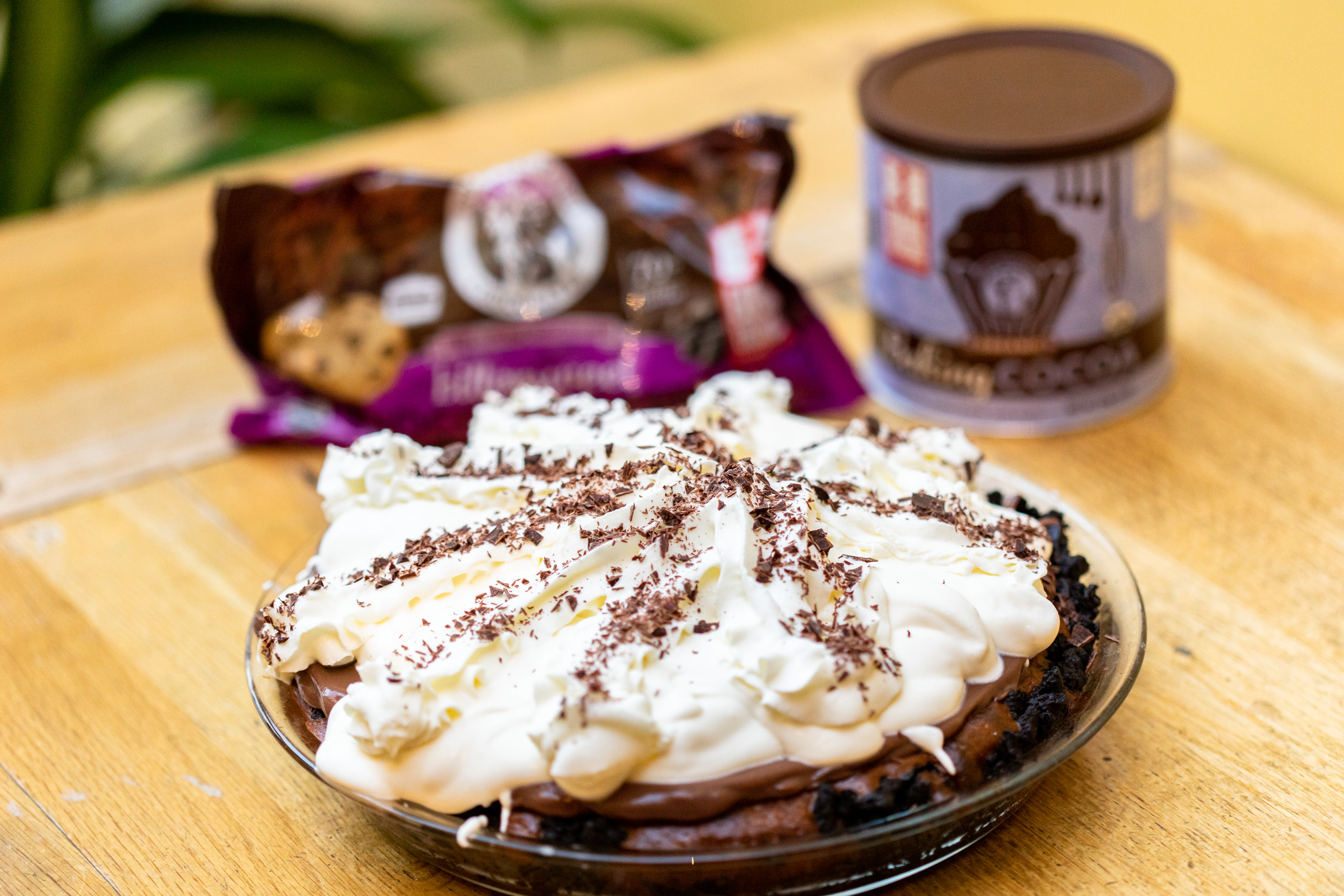
This decadent pie is a chocolate-lover's dream. Organic baking cocoa and chocolate chips give it a depth of flavor.
Enjoy!
To learn more about the Norske Nook, visit them on the web. And for more pie recipes, check out their cookbook, available for sale online.
Want more fair trade recipes, news and stories? Sign up for our twice-monthly newsletter!
Newsletter sign-up is not currently available.
Love candy? When you make your own Fair Trade Almond Joys, you know exactly what’s in them. In the case of these delightful bites, that means almonds and chocolate that are fair trade and organic! Mimi Clark of Veggie Gourmet shared this vegan recipe, which uses brown rice syrup, a low-fructose sweetener.

Place each candy on a plate lined with waxed paper. Refrigerate until set, around 15 minutes. Or freeze. (You want to allow the candy to warm before eating — it tastes best at room temperature.)
If you enjoyed this recipe, try some of our other fair trade desserts! And sign up for our twice-monthly newsletter.
Newsletter sign-up is not currently available.

